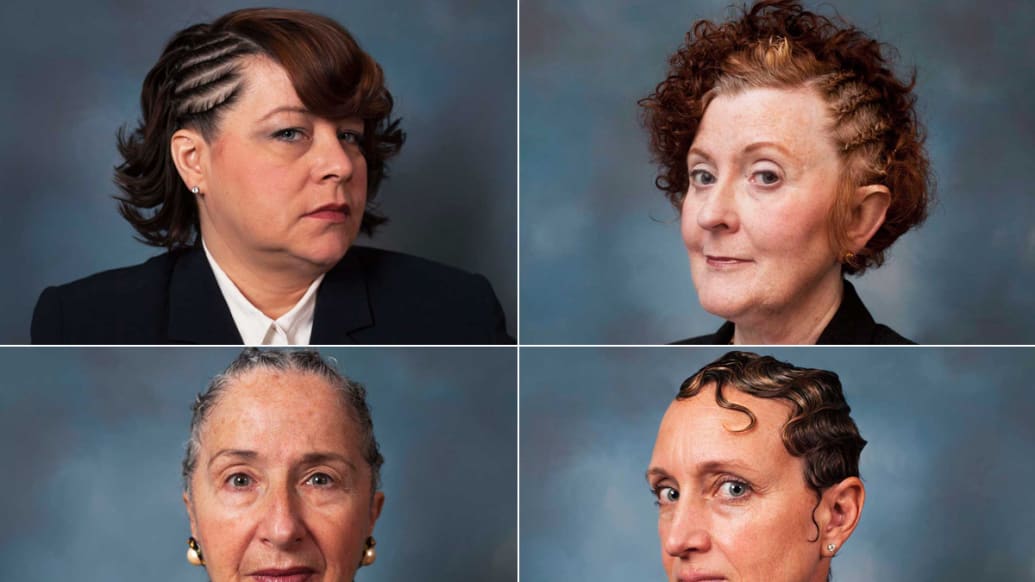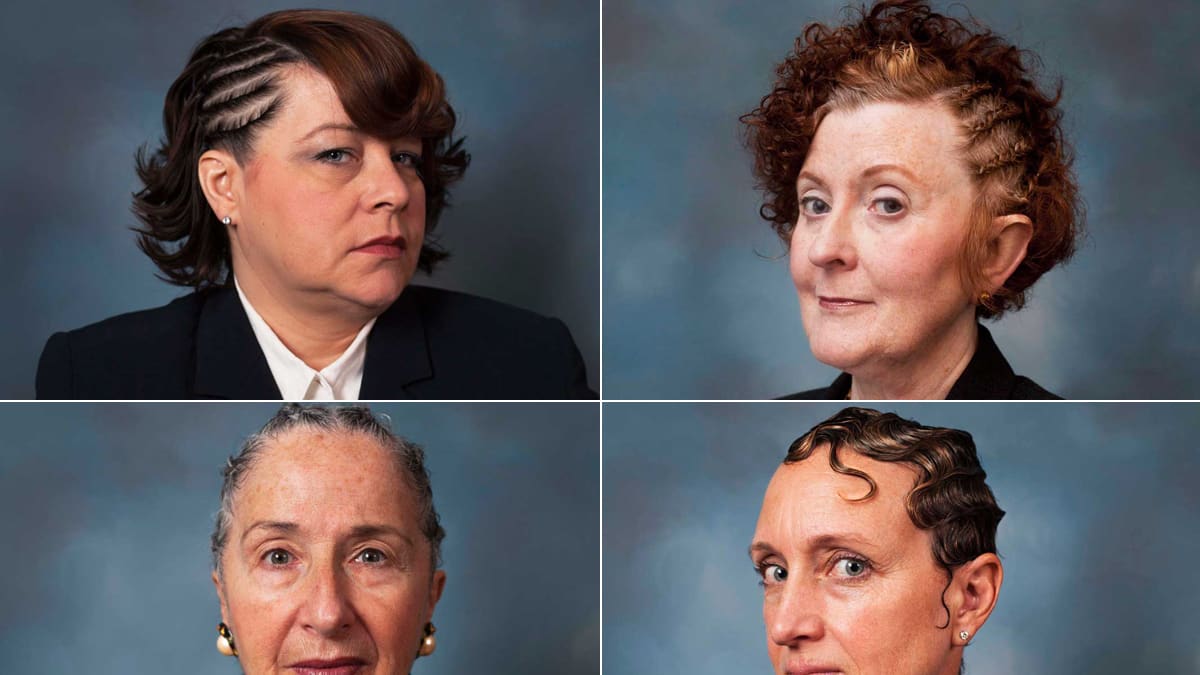When Endia Beal began her internship in Yale University’s IT department, her big, red Afro would stick up over the cubicles. Her white male co-workers were fascinated with her hair; many had never seen anything like it. Finally, someone told her: They all wanted to touch it.

She let them touch it—but Beal, 28, a photography MFA candidate there, wouldn’t let the interaction go down without proper documentation. So she staged a sort of performance; she invited the men to pull her hair and then asked them to reflect on the experience on videotape.
The project inspired Beal to begin thinking about how women are perceived in corporate environments; how appearance, body language—and hair—are all subtle codes that affect the way they’re treated. During a five-week residency at Woodstock’s Center for Photography this summer, she took the concept one step further, initiating a project called “Can I Touch It?” a series of portraits of white, middle-age women from the corporate world wearing hairstyles traditionally associated with African-American culture.
The result is a striking series of photographs of women posed in way that partly resembles a corporate headshot—and partly a Renaissance portrait.
Beal spoke to The Daily Beast about how the project came about—and how she hopes it will drive a dialogue about women in the workplace going forward.
“Can I Touch It?” Tell me where the idea for the project came from.
I recently graduated from Yale University with my master’s in fine arts. While I was at Yale, I was interning in Yale’s IT [Department]. I’m tall—I’m like 5’10”, and my hair is really big. I have a big red Afro. You could see me over the cubicles, literally. My colleagues were mostly men —white men. A co-worker of mine came to me one day and said the men were really fascinated by my hair. Some people were even talking about wanting to touch it. I decided, being an artist, that I would set up two video cameras in the office and allow the men to touch my hair. I didn’t want them to touch it—I wanted them to pull it. I wanted them to get a real good grip on it in their hands, because I knew for a lot of them it was the first time they had touchéd a black woman’s hair before. A week later, I came back and I interviewed them and I asked them, “How was that experience?”
For many of them, it was a new experience that they had never had. For me, it was the idea of being in a space and being uncomfortable. And having to perform in that space. The idea of not conforming and being yourself but having to deal with the obstacles of having this kind of hair within this particular environment. I was trying to think of ways to take the project to another level. A lot of the women, my female coworkers, were more forthcoming with their opinions. They were fascinated by it and would ask questions, like could the hair do that, and could they touch it.
So I decided some of the women I knew, and some I met were strangers, but I asked them if they could participate in this project and allow me to participate in this black-hair salon, do their hair, and we could talk about the experience of being a minority woman within that space.
What I found that was extremely fascinating was that being a 28-year-old black woman, I can relate to the same experiences as a white woman who is middle-aged.
These women talked about their experiences that were completely relevant to my experiences working in IT. The experiences that I had were experiences that crossed generational gaps; that crossed race, that crossed gender.
What kind of experiences?
One of the women, her name was Desiree, she said that when she started working in the corporate world, they told her that her name wasn’t appropriate. They told her that she had to change her name that was more fitting to the office environment. Another woman who had big, curly hair—they told her that her hair was a little distracting in the boardroom, and asked her if she could send a representative in to replace her so that people wouldn’t be distracted by her hair. So these are all experiences about being the “other” within that space. It’s not just a minority experience, but it’s the experience people across genders, across race, across generations can relate to: the idea of having to perform, to be somebody different, in that space.
How did the women in your photographs react when you initially approached them with this idea?
At first, they were pretty taken aback. Once I explained to them what I was doing, they were completely on board. I asked a lot of women and I received a lot of no’s. But the women who were willing to take that risk—they were on board. They understood the purpose of it, and they understood the impact that it could have, in talking about the ideas of being in that space.
And these were all women from the corporate world?
Some of the women were in the corporate world, others had had experience within that space.
Tell about the experience of actually going to the salon?
I did my residency at the Woodstock Center for Photography. The center was really helpful in finding a salon that would be appropriate for me to take the women to get their hair done. And for a lot of the women, it was the first time going into a black salon and even learning the names of some of the styles. We were talking about the different hairstyles that I wanted. All of the hairstyles that the women wore were hairstyles that I have worn before. So every hairstyle I’ve actually rocked at one time in my life.
Like what?
Some of them have basic cornrows and finger-waves; one woman has a “flat twist with waterfalls.” (She has a flat twist on one side, and then she has waterfalls in the back, so her hair kind of flips up in the back.)
We went into the salon one woman at a time. We walked in, and I told her what kind of style she was going to get, and the stylist would do her hair. We took footage of the process, and I would photograph each woman while she was getting her hair done. Sometimes the women would want me to take photographs with their phones so they could send it to their friends because for a lot of them it was a brand new experience. The understanding was no matter how the style came out, the women would have to take the portrait in the end.
Did they have to keep the styles in their daily lives?
Some of the women kept the styles, and some of the women didn’t.
How did the women react to their new hairstyles?
It was a mixture of emotions. Some people loved it, some said, “This looks great—but it does not look great on me.” It was definitely a mixture of emotions. It’s the idea of really stepping outside of your comfort zone to try something new.
When you were setting out to do this, did you have an idea of what kind of conversation you wanted to provoke from this project?
It was not so much a reaction, but I guess I was in search of a dialogue. It was meant to provoke a question about the ideas behind the corporate space—of conformity within that space as minority women transition to natural hairstyles and have to question whether they can wear that particular hairstyle to work. And so for me it was about the idea of posing that question: What if this was the norm? What if this is how these women looked on a regular day? Would it make us see things about the corporate space, and the way we are supposed to look within that space as minority women?
Were you seeking to educate the women in your photographs about hairstyles they had never experienced?
I would say that I learned something from this experience—maybe even more than the women who participated. I came in with a certain idea of what it was going to be. I thought, there was no way these women are going to be able to relate to a 28-year-old black woman, but I was wrong. I realized that it’s not just a minority experience—it’s an experience that’s shared amongst women. When I was able to open that dialogue with these white women, we were able to have a conversation about it and they were able to relate to what I was doing. The project lends itself to that conversation: stepping outside our comfort zone and being willing enough to take the risk to ask those questions.
So what’s next?
The project is ongoing. I recently received a grant; the residency allowed me to start the project, and now the grant will allow me to complete it. So now I’m trying to get enough money to receive the funding to complete it. I’m looking to do more women, more hairstyles, but then allowing the women to go into the workspace. So we’re working on the video aspect of it so the women go into the workspace with their new look, and then get reactions based on it.
I have received so many messages from women who are inspired by the project. Who are just like, “Oh, you know, I just recently straightened my hair for this interview and I saw your article online and it made me think about those issues that I’ve never seen before in art.” Being able to see people who are in corporate spaces contact me and say “Your art project touchéd me in a way that really spoke to my experiences” is really awesome.

